“Drawn from the Collection”, new at Tate Britain, is a good old-fashioned miscellany of an exhibition. It starts with a group of drawings organised under the rubric “Face to Face”, the pretext for an engagingly diverse series of intimate encounters with the distant and not-so-distant past. Young Stanley Spencer, visionary in the making, glowers darkly from a self-portrait drawing of 1913. Lucian Freud’s glum Narcissist stares frozenly at his own reflection. Sir Joshua Reynolds depicts himself screaming in mock-dismay, in his so-called Self-Portrait as a Figure of Horror, of 1784 – a warm-up exercise for the dramatic history paintings that he once dreamed of painting, instead of the portraits that were his stock-in-trade. Nearby, David Hockney catches a benign likeness of his own mother, surrounded by the clutter of home, in a spider’s web of lines. Adding a pinch of morbidity to the mix, an anonymous eighteenth-century artist contributes a fine-boned study of the skull beneath the skin.
The principle of the engaging pot-pourri is followed throughout. “The Modern Figure” pits William Scott’s angular Nude Putting on Stockings of 1956 against Roger Hilton’s orgiastic coupling of wonky smudges, Two Nude Women, of 1965. John Bratby’s statuesque Susan Ballam, a Fifties siren in a midi, looks on, smoking cigarette pinched between the fingers of her left hand. Then comes “Studies from Art and Life”, a sufficiently broad category to include sundry neoclassicists’ drawings of life models and studies of plaster casts, as well as Thomas Gainsborough’s lightning-fast pencil portrait of his chambermaid, peeking from a doorway, of circa 1785-8.
“Stories Real and Imagined” flits from Henry Moore’s depictions of wartime slumberers, sheltering from bombs in the depths of the London Underground, to Hogarthian misdeeds and an obscure eighteenth-century fantasy of flight. Other sections are given over...


